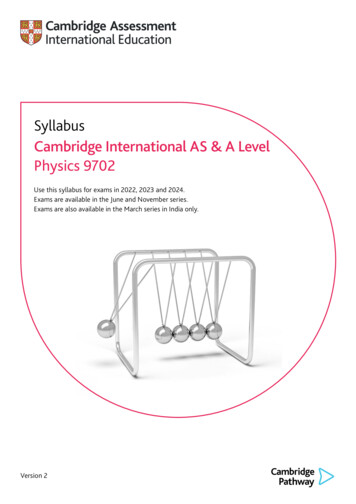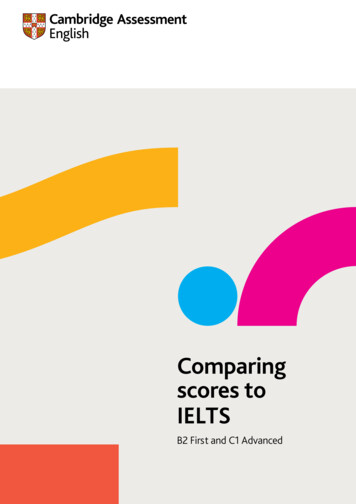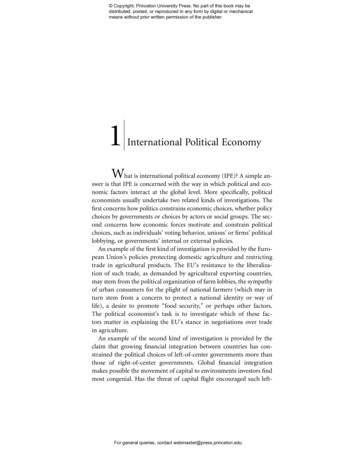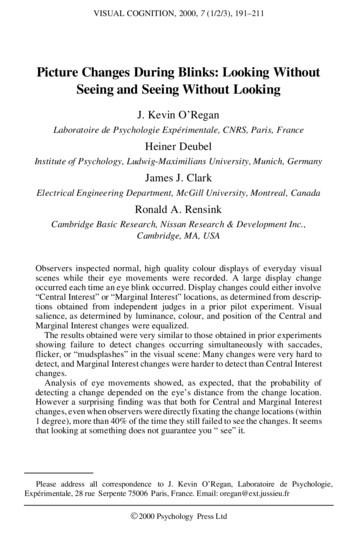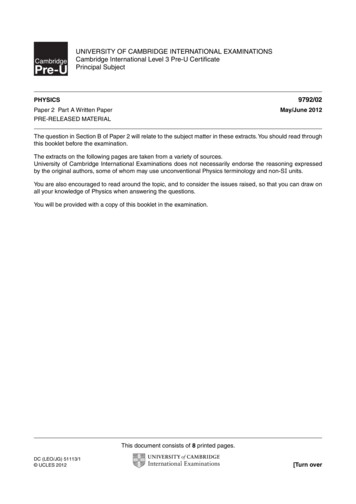
Transcription
UNIVERSITY OF CAMBRIDGE INTERNATIONAL EXAMINATIONSCambridge International Level 3 Pre-U CertificatePrincipal Subject9792/02PHYSICSPaper 2 Part A Written PaperPRE-RELEASED MATERIALMay/June 2012The question in Section B of Paper 2 will relate to the subject matter in these extracts. You should read throughthis booklet before the examination.The extracts on the following pages are taken from a variety of sources.University of Cambridge International Examinations does not necessarily endorse the reasoning expressedby the original authors, some of whom may use unconventional Physics terminology and non-SI units.You are also encouraged to read around the topic, and to consider the issues raised, so that you can draw onall your knowledge of Physics when answering the questions.You will be provided with a copy of this booklet in the examination.This document consists of 8 printed pages.DC (LEO/JG) 51113/1 UCLES 2012[Turn over
2Extract 1: How Maglev Trains WorkIf you’ve been to an airport lately, you’ve probably noticed that air travel is becoming more and morecongested. Despite frequent delays, aeroplanes still provide the fastest way to travel hundreds orthousands of miles. Passenger air travel revolutionised the transport industry in the last century, lettingpeople traverse great distances in a matter of hours instead of days or weeks.Fig. E1.1 The first commercial maglev line made its debut in December of 2003.The only alternatives to aeroplanes – feet, cars, buses, boats and conventional trains – are just tooslow for today’s fast-paced society. However, there is a new form of transport that could revolutionisetransport in the 21st century the way aeroplanes did in the 20th century.A few countries are using powerful electromagnets to develop high-speed trains, called maglev trains.Maglev is short for magnetic levitation, which means that these trains will float over a guideway usingthe basic principles of magnets to replace the old steel wheel and track trains. This is known aselectromagnetic suspension.Electromagnetic Suspension (EMS)If you’ve ever played with magnets, you know that opposite poles attract and like poles repel eachother. This is the basic principle behind electromagnetic propulsion. Electromagnets are similar to othermagnets in that they attract other magnetic objects, but the magnetic pull is temporary.There are three components to the maglev system: a large electrical power sourcemetal coils lining a guideway or tracklarge guidance magnets attached to the underside of the trainThe big difference between a maglev train and a conventional train is that maglev trains do not havean engine – at least not the kind of engine used to pull typical train carriages along steel tracks. Theengine for maglev trains is rather inconspicuous. Instead of using fossil fuels, the magnetic field createdby the electrified coils in the guideway walls and the track combine to propel the train. UCLES 20129792/02/PRE/M/J/12
3Fig. E1.2 An image of the guideway for the Yamanashi maglev test line in JapanAdapted from: Bonsor, Kevin. “How Maglev Trains Work” 13 October 2000. HowStuffWorks.com. -equipment/maglev-train.htm 11 January 2011. UCLES 20129792/02/PRE/M/J/12[Turn over
4Extract 2: The Shanghai Airport MaglevFig. E2.1 Transrapid train emerges from the stylish station in ShanghaiConstruction began in April 2001 of the first commercial Transrapid system. Despite the fact that themaglev was the first revenue-producing point-to-point high-speed maglev in the world, the system wasup and running by 2004. The 30 km line runs between Pudong Shanghai International Airport andthe Shanghai Lujiazui financial district. An end-to-end ride takes about eight minutes. A world recordfor commercial maglev systems was set on November 12, 2003. A five-section train achieved the topspeed of 501 km / h (311 mph) while another vehicle passed at 430 km / h (267 mph) on the adjacenttrack. The Transrapid in Shanghai has a design speed of over 500 km / h and a regular service speed of430 km / h. Shanghai Maglev is the fastest railway system in commercial operation in the world. Othermaglev lines are under consideration in China.Fig. E2.2 History-making maglev speeds between stationsAdapted from: http://www.monorails.org/tmspages/magshang.html UCLES 20129792/02/PRE/M/J/12
5Extract 3: Trains without wheels or frictionIntroductionThe principle of a magnet train is that it floats on a magnetic field and is propelled by a linear inductionmotor. The train follows guidance tracks with magnets. These trains are often referred to as MagneticallyLevitated trains – abbreviated to maglev.Fig. E3.1How it worksA maglev train floats about 10 mm above the guideway on a magnetic field. It is propelled by theguideway itself, rather than an onboard engine, by changing magnetic fields (see below). Once thetrain is pulled into the next section the magnetism switches so that the train is pulled on again. Theelectromagnets run the length of the guideway.Fig. E3.2What is the advantage of Maglev?Well it sounds high-tech, a floating train, they do offer certain benefits over conventional wheel-on-railrailways. The primary advantage is maintenance. Because the train floats along there is no contactwith the ground and therefore no need for any moving parts. As a result there are no components thatwould wear out. This means that in theory the trains and track would need no maintenance at all. Thesecond advantage is that because maglev trains float, there is no friction. Note that there will still beair resistance. A third advantage is less noise; because there are no wheels running along there is nowheel noise. However noise due to air disturbance still occurs. The final advantage is the high speed.This last advantage is a consequence of the other three. It is possible for conventional trains to travelextremely fast, say 500 km/h or 300 mph, but it is not economically viable. Another advantage is that theguideway can be made a lot thicker in places, e.g. after stations and going uphill, which would meana maglev could accelerate to 300 km/h (186 mph) in only 5 km where a conventional train takes 18 km.Furthermore, greater gradients would be manageable. UCLES 20129792/02/PRE/M/J/12[Turn over
6What are the disadvantages of Maglevs?There are several disadvantages with maglev trains. Maglev guide paths are bound to be more costlythan conventional steel railways. The other main disadvantage is the lack of existing infrastructure. Forexample, if a high speed line between two cities is built, then high speed trains can serve both citiesbut more importantly they can serve other nearby cities by running on normal railways that branch offthe high speed line. The high speed trains could go for a fast run on the high speed line, then comeoff it for the rest of the journey. Maglev trains wouldn’t be able to do that as they would be limited towhere maglev lines run. This would mean it would be very difficult to make construction of maglev linescommercially viable unless there were two very large destinations being connected. Of the 5000 kmthat TGV trains serve in France, only about 1200 km is high speed line, meaning 75% of TGV servicesrun on existing track. The fact that a maglev train will not be able to continue beyond its track mayseriously hinder its usefulness.Are maglevs really more environmentally friendly?In terms of energy consumption, maglev trains are slightly better off than conventional trains. Thisis because there is no wheel-on-rail friction. That said, the vast majority of the resistive force at highspeed is air resistance which means the energy efficiency of a maglev is only slightly better than aconventional train.German engineers also claim that a maglev guideway takes up less room and because greatergradients are acceptable there need not be so many cuttings and embankments, meaning that a newguideway would be less disruptive to the countryside than a new high speed conventional railway.Will maglevs replace conventional trains?Provided maglev can be proved to be commercially viable (which has not yet been done) it should bea success. Most people have their eyes on Germany, where the first maglevs will run in commercialservice. This may decide whether or not maglevs will be used across the world. Maglev may becomethe preferred path for new high-speed railway lines although it would depend whether or not serviceswere needed to stretch beyond a high speed line. For example, if you have 300 km of conventionaltrack between two cities cleared for over 200 km/h but there was a 60 km long section only cleared for80 km/h then it would make sense to build a new high speed (300 km/h) line for the 60 km distance. If amaglev train were to be used a track 300 km long would have to be built.Whether or not new railway lines stop being built in favour of maglevs, one thing is certain, with31 932 km of track in the UK, 34 449 km in France and 40 726 km in Germany, no one is going to convertall of this into maglev track. Conventional trains are here to stay for a long time.Adapted from: http://www.o-keating.com/hsr/maglev.htm UCLES 20129792/02/PRE/M/J/12
7Extract 4: Linear induction motorsLinear motors are electric motors that produce motion in a straight line rather than rotational motion.In a traditional electric motor, the rotor (rotating part) spins inside the stator (static part); in a linearmotor, the stator is unwrapped and laid out flat and the “rotor” moves past it in a straight line. Linearmotors often use superconducting magnets, which are cooled to low temperatures to reduce powerconsumption.Fig. E4.1 Photo: NASA tests a linear motor on a prototype Maglev railroad, 1999.Tracks like this could be used to launch vehicles into space in future.The basic principle behind the linear motor was discovered in 1895, but practical devices were notdeveloped until 1947. It was at this time that British electrical engineer Eric Laithwaite started toconsider whether linear motors could be used in electric weaving machines. Laithwaite’s research atImperial College, London attracted international recognition in the 1960s following a speech to theRoyal Institution entitled “Electrical Machines of the Future.”Linear motors are now used in all sorts of machines that require linear (as opposed to rotational)motion, including overhead travelling cranes and beltless conveyors for moving sheet metal. They areprobably best known as the source of motive power in the latest generation of high-speed “maglev”(magnetic levitation) trains, which promise safe travel at very high speeds but are expensive andincompatible with existing railroads. Most research on maglev trains has been carried out in Japan andGermany.Linear motors have a number of advantages over ordinary motors. Most obviously, there are no movingparts to go wrong. As the platform rides above the track on a cushion of air, there is no loss of energy tofriction or vibration (but because the air-gap is greater in a linear motor, more power is required and theefficiency is lower). The lack of an intermediate gearbox to convert rotational motion into straight-linemotion saves energy. Finally, as both acceleration and braking are achieved through electromagnetism,linear motors are much quieter than ordinary motors.Superconducting magnetsThe main problem with linear motors has been the cost and difficulty of developing suitableelectromagnets. Enormously powerful electromagnets are required to levitate (lift) and move somethingas big as a train, and these typically consume substantial amounts of electric power. Linear motorsoften now use superconducting magnets to solve this problem.If electromagnets are cooled to low temperatures using liquid helium or nitrogen their electricalresistance disappears almost entirely, which reduces power consumption considerably. This helpfuleffect, known as superconductivity, has been the subject of intense research since the mid 1980s andmakes large-scale linear motors that much more viable.Adapted from: http://www.explainthatstuff.com/linearmotor.html UCLES 20129792/02/PRE/M/J/12[Turn over
8Extract 5: Pros and cons of maglev and conventional trainsDue to the lack of physical contact between the track and the vehicle in a maglev system, there is norolling friction. There is only air resistance and a very small amount of electromagnetic drag.Maglevs can handle high volumes of passengers per hour (comparable to airports or eight-lanehighways) and do it without introducing air pollution along the track. Of course, the electricity has to begenerated somewhere, so the overall environmental impact of a maglev system is dependent on thenature of the grid power source.The weight of the large electromagnets in maglev designs is a major issue. A very strong magneticfield is required to levitate a massive train. For this reason one research path is using superconductorsto improve the efficiency of the electromagnets.The high speed of some maglev trains translates to more sound due to air displacement, whichgets louder as the trains go faster. A study found that high speed maglev trains are 5 dB noisier thantraditional trains. At low speeds, however, maglev trains are nearly silent.From: http://www.newworldencyclopedia.org/entry/Maglev trainCopyright Acknowledgements:Extract 1Extract 2Extract 3Extract 4Extract 5Extract 1 PhotographsExtract 2 PhotographsExtract 4 Photograph Kevin Bonsor; How Maglev Trains Work ; -equipment/maglev-train.htm http://www.monorails.org/tmspages/magshang.html http://www.o-keating.com/hsr/maglev.htm http://www.explainthatstuff.com/linearmotor.html http://www.newworldencyclopedia.org/entry/Maglev train Railway Technical Research Institute Transrapid International NASA Marshall Space Flight CenterPermission to reproduce items where third-party owned material protected by copyright is included has been sought and cleared where possible. Everyreasonable effort has been made by the publisher (UCLES) to trace copyright holders, but if any items requiring clearance have unwittingly been included, thepublisher will be pleased to make amends at the earliest possible opportunity.University of Cambridge International Examinations is part of the Cambridge Assessment Group. Cambridge Assessment is the brand name of University ofCambridge Local Examinations Syndicate (UCLES), which is itself a department of the University of Cambridge. UCLES 20129792/02/PRE/M/J/12
Extract 2: The Shanghai Airport Maglev Fig. E2.1 Transrapid train emerges from the stylish station in Shanghai Construction began in April 2001 of the first commercial Transrapid system. Despite the fact that the maglev was the first revenue-producing point-to-point high-speed ma

